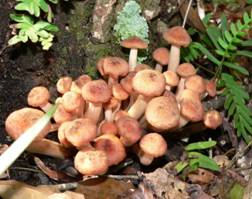Armillaria root rot
Natural History

Mushrooms produced by armillaria
Photo credit: Dr. Jason Smith, UF, SFRC
Armillaria root rot (also known as "shoestring root rot" or "honey mushroom") is caused by a mushroom-producing fungus (Armillaria spp.) that feeds on dead and living roots and woody debris in soils. The rot can attack the roots of living trees, causing a variety of above-ground symptoms as it interferes with the vascular system. Infected trees often start to lean and eventually fall over as the fungus destroys the root systems that hold them up.
The Armillaria fungus is capable of infecting new areas through the air, via wind dispersal of the spores, but its primary mode of spreading is underground. Once one tree in an area becomes infected, the fungus can move directly into neighboring trees wherever the roots of those trees make contact underground. In addition, in the absence of root contact, the fungus is also capable of producing black root-like structures known as rhizomorphs that move through the soil in search of new hosts. (The common name of "shoestring root rot" refers to the appearance of those rhizomorphs.) Usually, trees stressed by drought, flooding, insects and other diseases are affected most by Armillaria. In Florida, oak trees (especially laurel oaks) are particularly susceptible.
One of the interesting things about Armillaria is that, by spreading underground through the rhizomorphs, a single, continuous piece of the fungus can attain enormous size and mass. In fact, one specimen discovered near Crystal Falls, Michigan is claimed (by some) to be the oldest and largest single organism on earth. According to the official city website for Crystal Falls, the fungus "is believed to be 1,500 to 10,000 years old and weigh about 100 tons - about the same as an adult blue whale."
Another interesting thing about Armillaria is that the mycelium (the spongy, white part that grows under the bark of infected trees) is often bioluminescent, which means that it gives off light. You can try to see the effect by going into a darkened room, allowing your eyes some time to adjust, and then opening up an infected piece of wood. The amount of light given off by the mycelium can vary quite a bit, but you should see at least some light coming out. Other bioluminescent fungi are known to exist, but Armillaria is probably the species that is best known and most widely distributed.
